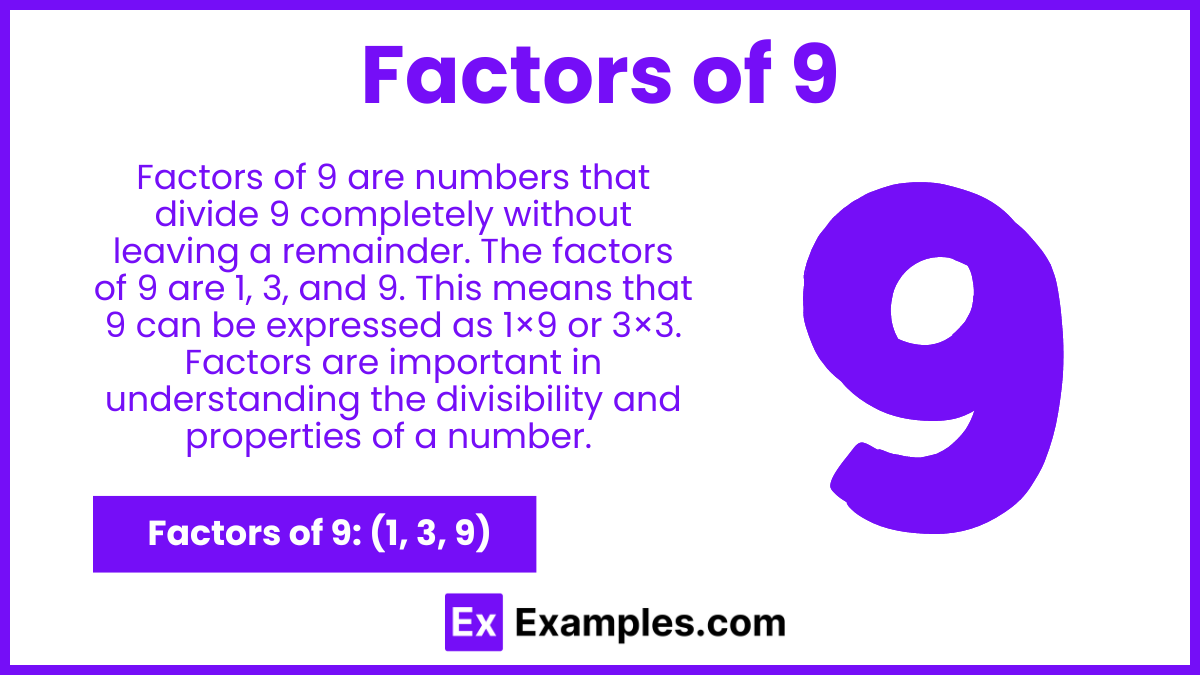Which of the following is a factor of 9?
6
9
12
15

The factors of 9 are 1, 3, and 9. Factors are numbers that divide another number completely without leaving a remainder. For 9, these specific factors can be multiplied in pairs to produce the number 9, such as 1×9 and 3×3. Understanding the factors of a number is essential for various mathematical applications, including simplifying fractions, finding the greatest common divisors, and solving problems involving divisibility. Recognizing that 9 is a perfect square (3×3) provides additional insight into its properties and its relationship with other numbers. Factors play a crucial role in number theory and arithmetic operations.

The factors of 9 are the numbers that can be multiplied in pairs to result in the product of 9. These factors are 1, 3, and 9. The number 1 is a factor of every number, including 9, as any number multiplied by 1 remains unchanged. The number 3 is particularly significant because it is both a factor and the square root of 9. Lastly, 9 itself is a factor because any number multiplied by 1 results in the number itself. These factors play a critical role in various mathematical operations and concepts, especially in the fields of algebra and number theory.
The pair factors of 9 are the pairs of integers that multiply together to give the product 9. Here are the pair factors of 9:
These pairs include one pair where both numbers are the same (3, 3), reflecting the fact that 9 is a perfect square.
Calculating the prime factors of a number involves breaking it down into its basic prime number components. For the number 9, the process involves identifying the smallest prime numbers that, when multiplied together, result in 9. Here is a step-by-step guide to calculate the prime factors of 9:
The factors of a number, like 9, can be simplified by following some basic tips. These tips can help you quickly identify the factors and understand their significance in various mathematical contexts.
The negative factors of 9 are -1, -3, and -9. These are simply the negative counterparts of the positive factors.
The prime factorization of 9 is 32. This means that 9 can be expressed as the product of the prime number 3 multiplied by itself: 3×3=9
To find the sum of all factors of 9, you add up the factors: 1+3+9=13. Therefore, the sum of all factors of 9 is 13.
No, 9 is not a prime number because it has factors other than 1 and itself. It can be divided by 3, making it a composite number.
The number 9 is a perfect square, as it can be expressed as 32. It is also an odd number and a composite number.
To determine if a number is a factor of 9, divide 9 by that number. If the result is a whole number without any remainder, then the number is a factor of 9.
Yes, 9 has exactly three factors: 1, 3, and 9. These are the numbers that can divide 9 without leaving any remainder.
The multiples of 9 are numbers that can be obtained by multiplying 9 by integers. Some multiples include 9, 18, 27, 36, 45, and so on.
The highest common factor (HCF) of 9 and another number is the largest number that divides both without a remainder. For example, the HCF of 9 and 12 is 3.
The factor tree of 9 involves breaking it down into its prime factors: 9→3×3.
Text prompt
Add Tone
10 Examples of Public speaking
20 Examples of Gas lighting
Which of the following is a factor of 9?
6
9
12
15
What are the factors of 9?
1 and 9
2 and 4
3 and 6
1, 3, and 9
Which of the following numbers is not a factor of 9?
3
4
9
10
If a number is divisible by 9, which of the following must be true?
It must end in 0 or 9.
The sum of its digits must be divisible by 9.
It must be a prime number.
It must be a multiple of 3.
What is the smallest factor of 9?
0
1
2
3
Which factor of 9 is also a prime number?
1
2
3
9
How many factors does the number 9 have?
2
3
4
5
Which of the following numbers is a multiple of 9?
8
18
20
27
Which pair of factors multiplies to give 9?
1 and 2
1 and 9
3 and 3
2 and 5
Which of the following numbers is a factor of 9 but not a multiple of 3?
9
1
3
6
Before you leave, take our quick quiz to enhance your learning!

